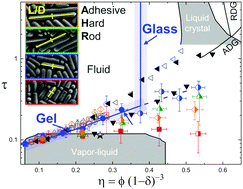Dynamic arrest of adhesive hard rod dispersions†
Abstract
The phenomenon of dynamic arrest, more commonly referred to as gel and glass formation, originates as particle motion slows significantly. Current understanding of gels and glasses stems primarily from dispersions of spherical particles, but much less is known about how particle shape affects dynamic arrest transitions. To better understand the effects of particle shape anisotropy on gel and glass formation, we systematically measure the rheology, particle dynamics, and static microstructure of thermoreversible colloidal dispersions of adhesive hard rods (AHR). First, the dynamic arrest transitions are mapped as a function of temperature T, aspect ratio L/D ≈ 3 to 7, and volume fraction ϕ ≈ 0.1 to 0.5. The critical gel temperature Tgel and glass volume fraction ϕg are determined from the particle dynamics and rheology. Second, an effective orientation-averaged, short-range attraction between rods is quantified from small-angle scattering measurements and characterized by a reduced temperature τ. Similar τ is found at low rod concentrations, indicating that rod gelation occurs at similar effective attraction strength independent of L/D. Monte Carlo simulations reveal a similar convergence in τ when rods cluster and percolate with an average bond coordination number 〈nc〉 ≈ 2.4, supporting the link between physical gelation and rigidity percolation. Lastly, AHR results are mapped onto a dimensionless state diagram to compare with previous predictions of attraction-driven gels, repulsion-driven glasses, and liquid crystal phases.



 Please wait while we load your content...
Please wait while we load your content...
